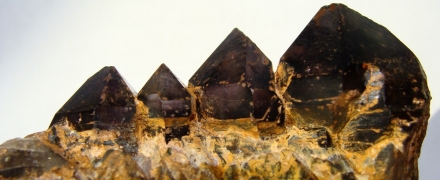open 10 am - 7 pm
laboratory is closed
Pegmatites - a source of gemstones

One of the types of deposits from which a large number of stones, including precious stones, are mined are pegmatites or pegmatite bodies. They are intrusive igneous formations enriched in highly volatile components. There are three hypotheses for the formation of pegmatites: 1. from residual granite melts; 2. by recrystallization of igneous rocks; 3. from residual magmatic melt with further recrystallization under the action of hydrothermal solutions. The formation temperature of pegmatite bodies varies in the range from 800 to 200 degrees. A characteristic feature of pegmatites is a coarse-crystalline structure, as well as the separation of monomineral blocks.
Depending on the composition of the source rocks and the conditions of formation, granite, hybrid, desilicated, alkaline and ultrabasic ones are distinguished. Interesting from the point of view of stones are granite pegmatites, that is, having an acidic composition. They contain such gems as topaz, aquamarine, varieties of beryl (except for emerald), as well as tourmaline.
However, the largest number of gemstones is concentrated in miarol pegmatites. They are formed at a relatively shallow depth and are characterized by the presence of cavities (miarol), in which various gems are formed. A feature of this type of pegmatite is a large amount of fluorine, which contributes to the formation of topaz, fluorite and lepidodite. In addition to them, you can find smoky quartz, spodumene, beryl, citrine, zircon and tourmaline in miarols.
В геммологической практике бывают весьма увлекательные случаи с диагностикой ювелирных вставок
Но помимо редкости цвета и высокой стоимости таких камней, многие розовые камни выделяются одной замечательной особенностью – они проявляют плеохроизм, то есть в зависимости от положения осмотра камня он может иметь дополнительные оттенки – оранжевый или пурпурный.
Currently, gemstones are produced by two fundamentally different technological methods - the High Pressure - High Temperature method (“HPHT”, High-pressure & High-temperature) and the Chemical Vapor Deposition (“CVD”, Chemical vapor deposition) method. The "HPHT" method is the most tested classical synthesis method, which can be used both carbon deposition on diamond from flux melts and catalytic reactions. In "CVD" synthesis, diamond growth occurs on a seed during carbon deposition mainly from a gaseous medium at relatively low temperatures and pressures.
Jewelry and precious stones are just such a category of goods, when buying which you need to pay attention to many criteria.
Sogdianite is a rather rare mineral and more often it can be found as a collection material (moreover, in systematic collections), and it is extremely rare in jewelry.






